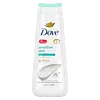What's inside
What's inside
 Key Ingredients
Key Ingredients

 Benefits
Benefits

 Concerns
Concerns

 Ingredients Side-by-side
Ingredients Side-by-side

Water
Skin ConditioningSodium Lauroyl Isethionate
CleansingSodium Methyl Lauroyl Taurate
CleansingCocamidopropyl Betaine
CleansingLauric Acid
CleansingSodium Hydroxypropyl Starch Phosphate
AbrasiveHydrogenated Soybean Oil
EmollientGlycine Soja Oil
EmollientSodium Chloride
MaskingGlycerin
HumectantStearic Acid
CleansingPalmitic Acid
EmollientHydrogenated Vegetable Glycerides
EmollientGlyceryl Stearate
EmollientHydroxystearic Acid
CleansingSodium Benzoate
MaskingGuar Hydroxypropyltrimonium Chloride
Skin ConditioningParfum
MaskingCitric Acid
BufferingCapryloyl Glycine
CleansingUndecylenoyl Glycine
CleansingSodium Gluconate
Skin ConditioningWater, Sodium Lauroyl Isethionate, Sodium Methyl Lauroyl Taurate, Cocamidopropyl Betaine, Lauric Acid, Sodium Hydroxypropyl Starch Phosphate, Hydrogenated Soybean Oil, Glycine Soja Oil, Sodium Chloride, Glycerin, Stearic Acid, Palmitic Acid, Hydrogenated Vegetable Glycerides, Glyceryl Stearate, Hydroxystearic Acid, Sodium Benzoate, Guar Hydroxypropyltrimonium Chloride, Parfum, Citric Acid, Capryloyl Glycine, Undecylenoyl Glycine, Sodium Gluconate
 Reviews
Reviews

Ingredients Explained
These ingredients are found in both products.
Ingredients higher up in an ingredient list are typically present in a larger amount.
Citric Acid is an alpha hydroxy acid (AHA) naturally found in citrus fruits like oranges, lemons, and limes.
Like other AHAs, citric acid can exfoliate skin by breaking down the bonds that hold dead skin cells together. This helps reveal smoother and brighter skin underneath.
However, this exfoliating effect only happens at high concentrations (20%) which can be hard to find in cosmetic products.
Due to this, citric acid is usually included in small amounts as a pH adjuster. This helps keep products slightly more acidic and compatible with skin's natural pH.
In skincare formulas, citric acid can:
While it can provide some skin benefits, research shows lactic acid and glycolic acid are generally more effective and less irritating exfoliants.
Most citric acid used in skincare today is made by fermenting sugars (usually from molasses). This synthetic version is identical to the natural citrus form but easier to stabilize and use in formulations.
Read more about some other popular AHA's here:
Learn more about Citric AcidWater. It's the most common cosmetic ingredient of all. You'll usually see it at the top of ingredient lists, meaning that it makes up the largest part of the product.
So why is it so popular? Water most often acts as a solvent - this means that it helps dissolve other ingredients into the formulation.
You'll also recognize water as that liquid we all need to stay alive. If you see this, drink a glass of water. Stay hydrated!
Learn more about Water